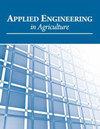AFU-Net:一种新的水稻叶病分割U-Net网络
IF 0.9
4区 农林科学
Q4 AGRICULTURAL ENGINEERING
引用次数: 0
摘要
强调注意机制增强了模型学习编码器中特定语义信息的能力。重新设计的残差结构在减少参数数量的同时加深了网络。特征提取模块和特征融合模块获得更丰富的边界特征信息,有效整合不同层次的输出结果。AFU-Net在自建数据集中的mIoU、mPA和Precision值分别为87.25%、92.23%和99.67%。摘要水稻病害对水稻生长和产量产生不利影响。精确的现场分割有助于评估疾病的严重程度,以便采取适当的控制措施。本文提出了一种水稻叶片病害的AFU-Net分割方法,并通过实验对其性能进行了验证。该方法在传统UNet的基础上,结合了注意机制、残差模块和特征融合模块(FFM)。跳跃式连接中嵌入了注意机制,增强了编码器层对特定语义特征的学习。此外,残差模块被集成到解码层中,使得网络深度加深,能够提取更丰富的语义信息。所提出的FFM结构有效地增强了边界信息和局部细节特征的学习。实验结果表明,该模型在自建水稻叶病分割数据集上的平均交联度(mIoU)、平均像素精度(mPA)和精度分别为87.25%、92.23%和99.67%。三个评价指标均较对照组有所提高,且所提模型参数数量最少,对较小的病点和特征不明显的病部位分割效果较好。关键词:注意机制,特征融合模块,残差模块,水稻叶片,UNet模型本文章由计算机程序翻译,如有差异,请以英文原文为准。
AFU-Net: A Novel U-Net Network for Rice Leaf Disease Segmentation
Highlights The attention mechanism enhances the ability of the model to learn specific semantic information in encoder. The redesigned residual structure deepens the network while reducing the number of parameters. The feature extraction module and feature fusion module obtain richer boundary feature information and effectively integrate output results from different levels. The mIoU, mPA, and Precision values of AFU-Net in the self-built dataset are 87.25%, 92.23%, and 99.67%, respectively. Abstract. Rice diseases adversely affect rice growth and yield. Precise spot segmentation helps to assess the severity of the disease so that appropriate control measures can be taken. In this article, we propose a segmentation method called AFU-Net for rice leaf diseases, and its performance is verified through experiments. Based on the traditional UNet, this method incorporates an attention mechanism, a residual module and a feature fusion module (FFM). The attention mechanism is embedded in skip connections, which enhances the learning of particular semantic features in the encoder layer. In addition, the residual module is integrated into the decoder layer, which deepens the network and enables it to extract richer semantic information. The proposed FFM structure effectively enhances the learning of boundary information and local detail features. The experimental results show that the mean intersection over union (mIoU), mean pixel accuracy (mPA) and Precision of the proposed model on the self-built rice leaf disease segmentation dataset are 87.25%, 92.23%, and 99.67%, respectively. All three evaluation indexes were improved over the control group, while the proposed model had the lowest number of parameters and displayed a good segmentation effect for smaller disease points and disease parts with less obvious characteristics. Keywords: Attention mechanism, Feature fusion module, Residual module, Rice leaves, UNet model.
求助全文
通过发布文献求助,成功后即可免费获取论文全文。
去求助
来源期刊

Applied Engineering in Agriculture
农林科学-农业工程
CiteScore
1.80
自引率
11.10%
发文量
69
审稿时长
6 months
期刊介绍:
This peer-reviewed journal publishes applications of engineering and technology research that address agricultural, food, and biological systems problems. Submissions must include results of practical experiences, tests, or trials presented in a manner and style that will allow easy adaptation by others; results of reviews or studies of installations or applications with substantially new or significant information not readily available in other refereed publications; or a description of successful methods of techniques of education, outreach, or technology transfer.
 求助内容:
求助内容: 应助结果提醒方式:
应助结果提醒方式:


